Understanding the Tablet Form Factor
Is that a burnt toaster pastry you're holding to your ear, or is that a phone? Yeah, you've seem them — the guys holding a huge rectangle phone to their ear. It seems that the device manufacturers are constantly trying to reinvent. Would you do that with a tablet? No, probably not, unless you're watching funny cat videos on YouTube and you can't hear the volume. But this brings up the important point of form factor.
Keep that previous image in your head — you holding a tablet held to your ear. That doesn't seem right, now does it? But a phone, sure, why not? That seems plausible. Form factor — in this instance — is the form of the device itself. The size of my Nexus One is 2.3″ wide and 4.6″ in height. Juxtapose this with the size of the XOOM tablet at 6.6″ wide and 9.8″ in height (assuming the device is held in portrait position). Just by looking at the dimensions alone, you can see that they are completely different in size. Why does this matter to you? Simple — if the size is different, the user experience is different.
The size of something that you hold in your hand dictates how you interact with it. Imagine how you hold a newspaper — probably with both hands. Now imagine reading a single-page pamphlet — probably with one hand. The same goes for the usage of phones and tablets. Most users hold a tablet with two hands but a phone with one hand; see Figure 2-1.
Figure 2-1: Holding a Motorola XOOM with two hands on the left and a Nexus One with one hand on the right.

You can see that the form factor of these devices is completely different. The tablet requires using both hands to operate, but the phone requires only one hand to operate. Developing applications that accommodate to this form factor is the key to success when designing user interfaces for these devices.
